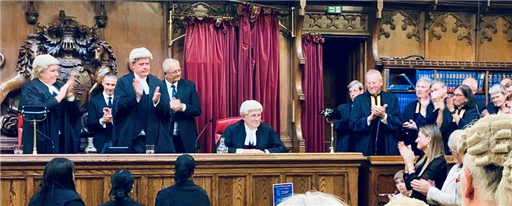
Cohabitation Rights in England and Wales, Scotland and Australia
Published: 03/07/2023 08:00

Introduction
Across the globe, the composition of families is changing. No longer is marriage the definitive means for defining a family; we have seen the growth of other formalised relationship statuses such as registered partnerships and civil unions. The family outside marriage has now become a statistical reality and something that policymakers should not readily ignore.
This article reflects on cohabitation from a comparative perspective. It explores the legal position in England and Wales, Scotland and Australia with a view to analysing how far couples are protected and the efficacy of the relevant legal frameworks. As will be shown, the law in England and Wales lags considerably behind the other two jurisdictions, and a key method of unlocking reform here is to learn from the experience of other countries.
Cohabitation rights in England and Wales
Cohabitation is the fastest growing family form.1 It jumped from 1.5 million in 1996 to around 3.6 million in 2021, representing an increase of 144%.2 That figure amounts to one in five couples today and is predicted to rise to one in four couples cohabiting by 2031. In 2021, of the 3.6 million couples cohabiting, around 1.2 million had dependent children and over half of all births were outside marriage (51.3%).
The legal position in England and Wales is complex, difficult to rationalise, and has failed to evolve adequately over time to reflect changing societal attitudes. There is no unified statutory regime, and any protections or entitlements cohabitants receive are highly context-specific. The definition of cohabitant in specific statutes is likely to vary as much as the eligibility criteria and remedies. In some contexts, cohabitants are treated in the same way as spouses or civil partners (e.g. applications for injunctions under the Family Law Act 1996) whereas in others they receive weaker protections or no protection at all.
Unlike the positions in Australia and Scotland, cohabitants in England and Wales receive inferior legal protections in two important contexts. Upon separation, courts possess no powers to adjust property rights and have no ability to order maintenance to a former partner. Instead, cohabitants are forced to use a property and trusts law framework to determine ownership of the family home, which is archaic, complex and difficult to navigate. Where children are involved, orders settling property for the benefit of a child can be sought under Children Act 1989, Sch 1, but this is under-used and generally only accessible by wealthy couples. The other context where a clear disparity in treatment arises is in relation to claims for financial provision following death. Unlike spouses or civil partners, cohabitants are not automatically entitled to property in an intestate succession. However, they are afforded slightly greater protection following death than separation as they can claim under the Inheritance (Provision for Family Dependents) Act 1975 for provision out of their former partner’s estate.
As a result, cohabitants can be unable to claim relief for relationship-generated disadvantage which, practitioners have noted, in practice, is more likely to affect women.3 The types of contributions made to a relationship and the division of labour within the home can have a huge impact on legal entitlements and there is clear potential for an economically stronger party to take advantage of the other.
This framework does not operate in a vacuum either. There is widespread misunderstanding among the population about legal entitlements, which is fuelled by the erroneous belief that merely living together creates a ‘common law marriage’. A NatCen survey revealed in 2019 that 46% of the population believed in the so-called ‘common law marriage myth’, which increased to 55% where children were present.4 Some might argue that the solution to this is better knowledge as to rights and the need to self-regulate, yet to date public awareness campaigns have not been able to dispel this myth. Equally, the potential of self-regulation as a ‘solution’ needs to be approached cautiously. While it is possible for couples to create cohabitation contracts, purchase property jointly and draft wills, cohabitants must be aware of the need to do that in the first place, which becomes complicated if they were labouring under the (incorrect) belief they were already protected by the law. And, of course, cohabitants must have the opportunity, financial resources and inclination to self-regulate. In practice, the uptake of cohabitation contracts is relatively low and the Law Commission estimated in 2017 that around 40% of the population do not have a will.5
Cohabitation rights in Scotland
The Family Law (Scotland) Act 2006 (the 2006 Act) is Scotland’s primary financial provision legislation for separating cohabitants. Prior to this enactment cohabitants had limited financial remedies when they separated. These were embedded mainly in statutory legislation6 and common law remedies.7 The Scottish Law Commission in its Report on Family Law8 wanted to redress the situation where, following the breakup of a committed cohabiting relationship, one party found themselves in a position of financial vulnerability. The 2006 Act, s 28 (commonly referred to in Scotland as a ‘s 28 claim’) was introduced in an attempt to address this.
Qualifying criteria for a ‘s 28 claim’
In order to qualify, a couple must meet the test of being in a cohabitating relationship.9 Parties, which include heterosexual or same sex couples, must have lived together as if they were husband and wife/civil partners. There is no length of time the couple must have lived together; the length of time is just one of the factors the court will take into account.
Jurisdiction
The 2006 Act, s 22 provides that jurisdiction can be based on domicile. Many Scottish academics10 believe that this section has retrospective effect. Accordingly, if your client has a Scottish domicile, while they currently live in England, Australia or elsewhere, they may be able to raise proceedings in Scotland.
The financial remedies available
On the basis that the couple meet the s 25 test,11 i.e. that they are in a cohabitating relationship, a separating cohabitant might be able to bring one of two main claims under s 2812 where slightly different tests apply, but they combine (if both are pleaded) when the court is deciding whether to make an ‘award’. An award takes the form of a capital sum payment which can be paid in instalments.13 This excludes a variety of orders that separated married Scottish couples can access, such as pension sharing orders, property transfer orders and orders for spousal aliment.14 Should cohabitants own a property in joint names then that property can be transferred by agreement or one party can raise an action for division and sale.15 The court does not have the power to make orders for periodical payments.
The ‘s 28’ tests
When considering the prospects of success for a s 28(2)(a) claim, i.e. for a capital sum, one should consider, first, whether one of the cohabitants has derived an economic advantage from contributions made by the other cohabitant who has suffered a corresponding economic disadvantage in the interests of the other cohabitant or the parties’ children.16 Secondly, the court will consider whether any economic advantage is offset by any economic disadvantage suffered by the other cohabitant in the interests of the other cohabitant or the parties’ children and vice versa.17
Section 28(2)(b) empowers the court to make an award in respect of an economic burden of caring for any children of the parties’ relationship after the end of the cohabitation. In order to be successful in this section, the offsetting provisions that we describe do not apply but it is still necessary for the cohabitant making a claim to persuade the court the s 28(3) test (noted in the previous paragraph, i.e. economic advantage and disadvantage) applies.
‘Contributions’ are defined18 as including indirect and non-financial contributions and includes contributions by looking after any relevant child. ‘Economic advantage/disadvantage’ is defined as including gains/losses in capital, income and earning capacity.
The significant ‘s 28’ case
The most important case dealing with s 28 in Scotland has been the Supreme Court case of Gow v Grant19 where it was decided that a ‘broad brush’20 approach should be taken with a focus on fairness rather than a precise calculation of loss.
Ancillary points
Section 28 has a very strict time bar,21 with no judicial discretion built in, that provides that a claim must be raised and served on the defender no later than 12 months from the date of their separation.
Written cohabitation agreements, akin to pre-nuptial agreements, are made between cohabiting couples in Scotland. There is, however, no provision in the current legislation for them to be recognised.
Future of cohabitation claims
It is fair to say that the majority of Scottish family lawyers and some of the judiciary22 have been dissatisfied with the s 28 test. The wording is complex, hard to interpret and it is difficult to advise clients of the level of claim that they are likely to receive from the court. In response, the Scottish Law Commission has very recently produced a report suggesting changes to s 28,23 including the introduction of property transfer orders, a more lenient approach to the 12-month time bar and a set of guiding principles to help with the tests to be applied. Whether the Commission’s recommendations will be taken forward, remains to be seen.
Cohabitation rights in Australia
To understand the position in Australia it is necessary to go as far back as the 1901 Constitution which established Australia as a Federation under a constitutional monarchy.
Before Federation, there were a series of independent colonies. Upon Federation, and through the Constitution, the new national (‘Commonwealth’) Parliament was given legislative power in relation to certain matters, while other residual legislative powers remained with the various Australian States.
Amongst the powers reserved to the Commonwealth Parliament was the power to make laws with respect to ‘divorce and matrimonial causes’.24 In the exercise of this power, in 1975, the Commonwealth Parliament passed legislation to create a comprehensive scheme regulating the rights of parties who had been married.25 Family relationships outside marriage (‘de facto partners’) were left to the legislatures of the various States.
In practice, this left claims between former de facto partners to be determined by the application of the ordinary law of property and equity. However, in 2002, one of the Australian States (Western Australia) passed legislation to create a comprehensive scheme regulating the financial rights of former de facto partners.26 In 2008, as a result of the Australian States referring their powers to the Commonwealth Parliament, legislation was passed at the federal level to create a national scheme regulating the rights of former de facto partners.27
As a result, since 2008 separated de facto parties have, in substance, had much the same rights to make financial claims as married parties.
Current legislation – eligibility to claim
There are a number of criteria which must be satisfied for former de facto partners to be eligible to claim under the legislation:
- There must have been what constitutes a ‘de facto relationship’. This is defined as being ‘a relationship as a couple living together on a genuine basis’.28 The circumstances which can be taken into account include:
- the duration of the relationship;
- the nature and extent of their common residence;
- whether a sexual relationship exists;
- the degree of financial dependence and interdependence, and any arrangements for financial support, between them;
- the ownership, use and acquisition of their property;
- the degree of mutual commitment to a shared life;
- whether the relationship is or was registered;
- the care and support of children; and
- the reputation and public aspects of the relationship.
- There must be a sufficient connection with Australia. This is satisfied if either of the parties is an Australian citizen, ordinarily resident in Australia or present in Australia on the day the application to commence proceedings is filed.29
- There must be a circumstance that warrants the making of an order – which is satisfied if any one or more of the following exists:30
- the duration of the relationship was at least 2 years;
- there is a child of the relationship;
- the applicant made substantial contributions and a failure to make an order would result in serious injustice; or
- the relationship was registered.
- The application must ordinarily be made within 2 years after the end of the relationship.31
Alteration of property interests
Where de facto parties are eligible to make a claim under the legislation, the court applies what is often described as a 4-step approach to determining the extent of their entitlements with respect to the alteration of property interests:
(1) At the first step, the court identifies the assets, liabilities and financial resources of the parties. This is a wide-ranging enquiry. For example:
- it is not limited to assets held in the personal names of the parties: it extends to any companies, trusts or other entities that they own or control;
- it extends to superannuation and pension interests;
- it is not limited to assets within Australia: it extends to assets wherever they are held worldwide; and
- it is not limited to assets acquired during the relationship: it extends to assets acquired before and after the relationship.
(2) The second step is to assess the respective contributions of the parties.32 Again, this is a wide-ranging enquiry. It includes not only financial contributions, but also contributions in other spheres such as contributions made in the capacity of homemaker or parent.
(3) The third step is to consider whether there are any factors that warrant an adjustment to what would otherwise be the contribution-based entitlements of the parties. The legislation specifies a range of factors which the court must consider in undertaking this exercise.33 Those matters include:
- age and state of health;
- income and capacity for work;
- care of a child;
- standard of living the parties enjoyed during their relationship; and
- enabling a party to undertake a course of education.
(4) After the contribution-based entitlement has been assessed, together with any adjustment, the fourth step is to ensure that the overall result is ‘just and equitable’.34 This underscores the discretionary nature of the process.
The court has wide power to make the type of order appropriate to satisfy the parties’ entitlement. This might include a combination of, for example, an order requiring the payment of an amount of money, an order for the sale or transfer of a particular piece of property, an order splitting a superannuation interest, etc.
Spousal maintenance
In addition to claims for alteration of property interests, separated de facto parties can also, in appropriate circumstances, claim maintenance from their former partner.
Ability to ‘contract out’
Parties have the option to make what might, in other contexts, be described as a pre-nuptial agreement. In the context of the Australian legislation, that type of agreement is described as a ‘financial agreement’. Essentially, the legislation gives parties the option to ‘contract out’ of what would otherwise be their legislative entitlements.
Once parties have made the decision to opt-out, there are essentially no rules as to the content or terms of their agreement. Instead, the parties are free to make an agreement on any terms that they find satisfactory.
The ‘safety net’ in the system is a requirement for each party to receive independent legal advice before they make such an agreement. The advice must cover matters including ‘the effect of the agreement’ and ‘the advantages and disadvantages … of making the agreement’.35
Conclusion
The question of cohabitation reform in England and Wales has received renewed interest over the past few years, most recently by the UK Parliament’s Women and Equalities Committee Report, The Rights of Cohabiting Partners.36 Released in August 2022, the Report noted the vulnerability that could arise following relationship breakdown and death and that it was exacerbated by the common law marriage myth. It called for increased public awareness of the differences between marriage, civil partnership and cohabitation and the specific issues generated by religious-only marriages, where their lack of legal recognition treats such couples as cohabitants. In addition, it called for the introduction of opt-out legal protections along the lines of those proposed by the Law Commission in its 2007 Report and the immediate introduction of intestacy and family provision reforms advocated in the Law Commission’s 2011 Report. The government responded in November 2022 and largely rejected all recommendations on the basis that reform projects in other areas of family law, notably weddings law and financial remedies, needed to be completed before cohabitation could be reviewed.37 The response is far from persuasive and reveals an unfortunate unwillingness by the government to tackle this important and pressing reform issue.
On 8 March 2023 the government also confirmed – when announcing that it would be asking the Law Commission to investigate financial remedy provision upon divorce including by way of comparative studies of other jurisdictions such as Australia – that the review would not encompass cohabitation law.38 This was reaffirmed by the Law Commission when it announced the scope of its investigation into financial provision on divorce on 4 April 2023. Whilst it is disappointing cohabitation reform is not higher on the government’s agenda, it is hoped that when the law regarding cohabitation is finally considered appropriate for reform by the government, it will look (as it is doing with financial provision on divorce) to the experiences in other jurisdictions where rights of cohabitants have been better protected for some time.












